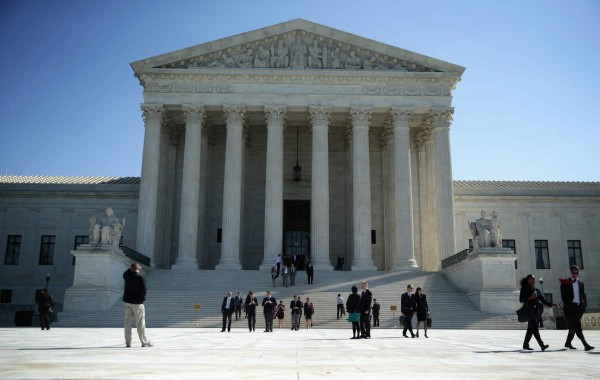
The U.S. Supreme Court handed President Donald Trump a significant defeat on Thursday, ruling that his administration did not give an adequate explanation for its plan to include a contentious citizenship question on the 2020 census and preventing its addition to the decennial survey for now.
The justices – in a 5-4 decision with Chief Justice John Roberts joining the court’s four liberals in the majority and writing the ruling – upheld part of a federal judge’s ruling barring the question in a victory for a group of states including New York and immigrant rights organizations that had challenged the plan.
Opponents of the question have called it a Republican ploy to scare immigrants into not taking part in the population count.
As part of the ruling issued on the last day of the court’s current term, the justices sent the issue back to the Commerce Department for it to decide how to proceed. But the clock is ticking, as census forms have to be printed in the coming months.
Further muddying the waters, there is also ongoing litigation in lower courts over recently unearthed evidence that the challengers have said reveals an illegal discriminatory motive by the administration for adding the question, which the high court could yet weigh in on.
The court ruled against the challengers on other claims, with the nine justices splitting in different ways. The court ruled on a separate 5-4 vote with the conservative justices in the majority that the U.S. Constitution does not in theory prevent the administration from adding a citizenship question.
Opponents have said the question would instill fear in immigrant households that the information would be shared with law enforcement, deterring them from taking part.
The census, required by the U.S. Constitution, is used to allot seats in the U.S. House of Representatives and distribute some $800 billion in federal funds. The intent of the citizenship question, opponents said, is to manufacture a deliberate undercount of areas with high immigrant and Latino populations, costing Democratic-leaning regions seats in the House, benefiting Republicans and non-Hispanic whites.
The administration argued that adding a question requiring people taking part in the census to declare whether they are a citizen was needed to better enforce a voting rights law, a rationale that opponents called a pretext for a political motive.
Roberts said that under a U.S. law called the Administrative Procedure Act, the federal government is required to give a reasoned explanation for its actions.
“Accepting contrived reasons would defeat the purpose of the enterprise,” Roberts wrote.
Roberts said that the explanation provided by the government was “more of a distraction.”
In a dissenting opinion, conservative Justice Clarence Thomas wrote that the decision to add the citizenship question was “legally sound” and described the ruling against Trump as “an aberration.”
The Republican president’s administration had appealed to the Supreme Court after lower courts blocked the inclusion of the census question. The Justice Department had previously told the Supreme Court it needed a final decision on whether the question could be added by the end of this month.
SETBACK FOR TRUMP
The ruling marked the first major setback for Trump in a ruling at the Supreme Court, although both of Trump’s appointees to the court, Neil Gorsuch and Brett Kavanaugh, voted in favor of his administration. Roberts was joined by liberal Justices Ruth Bader Ginsburg, Stephen Breyer, Sonia Sotomayor and Elena Kagan.
The Supreme Court had handed Trump some major victories since he took office in 2017, in particular a June 2018 ruling upholding his travel ban targeting people from several Muslim-majority countries. The court in January also let Trump’s policy barring many transgender people from the U.S. military go into effect.
Manhattan-based U.S. District Judge Jesse Furman ruled on Jan. 15 that the Commerce Department’s decision to add the question violated the Administrative Procedure Act. Federal judges in Maryland and California also have issued rulings to block the question’s inclusion, saying it would violate the Constitution’s mandate to enumerate the population every 10 years.
Furman said the evidence showed that Commerce Secretary Wilbur Ross concealed his true motives for adding the question and that he and his aides had convinced the Justice Department to request a citizenship question.
Businesses also rely on census data to make critical strategic decisions, including where to invest capital. Citizenship has not been asked of all households since the 1950 census, featuring since then only on questionnaires sent to a smaller subset of the population.
The Census Bureau’s own experts estimated that households corresponding to 6.5 million people would not respond to the census if the citizenship question were asked.
While only U.S. citizens can vote, non-citizens comprise an estimated 7 percent of the population.
Evidence surfaced in May that the challengers said showed that the administration’s plan to add a citizenship question was intended to discriminate against racial minorities.
Documents created by Republican strategist Thomas Hofeller, who died last year, showed that he was instrumental behind the scenes in instigating the addition of the citizenship question. He was an expert in drawing electoral district boundaries that maximize Republican chances of winning congressional elections.
Hofeller concluded in a 2015 study that asking census respondents whether they are American citizens “would clearly be a disadvantage to the Democrats” and “advantageous to Republicans and Non-Hispanic Whites” in redrawing electoral districts based on census data.
Hofeller suggested the voting rights rationale in the newly disclosed documents.
The Trump administration called the newly surfaced evidence “conspiracy theory.”
Most people living in the United States will be asked to fill out the census, whether online or on paper, by March 2020.
REUTERS
Leave a Reply
You must be logged in to post a comment.